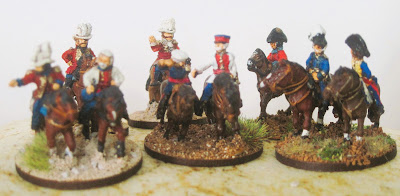My Anglo-Sikh War collection began in the last century. Consequently this post will remind me of what I have and what I might need to add. Above, the Rifles.
I also need to rate my forces for the Anglo-Sikh Wars. It has occasioned much thought and some revisions
to my previous thinking. Research will
do that. A good thing and of course the
thinking doesn’t stop.
Mostly the British liked a 2-1 combination. That is two
native units to one British one. The
latter could be Company or HM. Apart
from the irregulars all were trained in the British manner. Drilled seems a
reasonable category for all of the Regulars.
There is the question of superiority of British units. In fact there was little observable difference
in performance or staying power. Yet, the British commanders thought that there
was. To model this I’m trying out the British units as Drilled Elite and the
Sepoys and Sowars as simply Drilled.
A second question is what of the vaunted British Fire Power? Experimentally I intend to limit the
potential +D3 result to British Infantry units. Sepoys will not benefit.
The cavalry also followed the 2-1 model
Another Brigade. Note the Governor General's Body Guard in the back rank.
The final Regular cavalry Brigade. It could do with another unit of Bengal Native Cavalry. Or, maybe I will just attach the Horse Artillery.
The Indian irregular cavalry were a key component of the Army. You see three such units below.
The British fielded a lot of artillery often of lighter calibre that that of the Sikhs.
You see all of my British artillery below.
I realise I have no Bengal Native Artillery.
No shortage of guns though.
Various British Commanders below including two versions of Sir Hugh Gough. Governor General Hardinge's there too.
You can see my entire Anglo-Sikh War British Collection on this page. It has been quite a journey. We will see the Sikhs next time.














Handsome collection! Calibrating relative combat effectiveness is an art as well as science.
ReplyDeleteThanks Jonathan. Too true, it's an ongoing experiment.
ReplyDeleteA nice parade, lovely collection!
ReplyDeleteThanks Donnie.
DeleteSimply splendid collection there:).
ReplyDeleteThanks Steve. It's nice seeing them all together at last.
DeleteLovely looking collection.
ReplyDeleteCheers Richard!
DeleteThey look great OB....who knows if the British infantry were superior or if it's just British chauvinism? A bit of both, perhaps?
ReplyDeleteThanks Keith. It's a big question. They were tough boys. The Sepoys were generally physically better specimens and from hereditary military families. In Britain and Ireland joining the Army was often a desperate act. The last option if you like.
DeleteIndia was hard on non wealthy Europeans. Even out of combat mortality was high.
For serious assaults HM or Company European battalions were mostly required to lead the Brigade. I wanted to reflect the thinking behind that.
Currently, I think the racial thinking didn't really kick in until after the Sikh Wars.
I'm still thinking about the whole thing.
Well they all look rather dashing, don't they?
ReplyDeleteThey do Ray I'm pleased to agree!
ReplyDelete